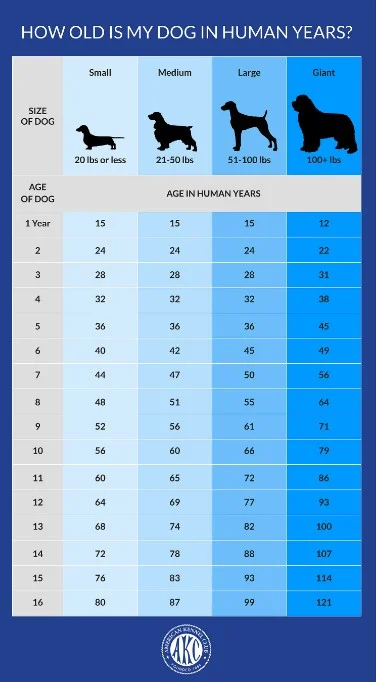If you are a dog owner there is a high probability that you’ve asked yourself one question: How old is my dog in human years?
It’s a good and interesting question, but it’s not that easy to give a correct answer. The main reason is that dogs age differently than humans. Also, dogs age differently depending on their size.
You have probably heard that one human year equals seven dog years. It’s a formula that’s been in use throughout history. However, this is not an accurate way of calculating your dog’s years for the reasons we have explained above.
How Old Is My Dog In Human Years?
Is one dog year equal to seven human years?
Despite the prevalent belief that a dog’s year is equivalent to seven human years, it’s not quite that straightforward. In fact, depending on your pet’s age and size, the dog-to-human age equivalent can alter from year to year. According to the American Kennel Club, all puppies gain roughly 15 human years in their first year of life, and another nine years in their second year of life.
However, the figures for the second year tend to be different. On paper, larger breeds “age faster,” meaning their human age equivalent will be higher than a smaller dog of the same age. This may sound depressing or even alarming, but keep in mind that age isn’t a predictor of health or life expectancy – it’s just a number!
Scientific Formula
To determine more accurately how old is your furry friend in human years, you can use a formula created by researchers from the University of California San Diego School of Medicine.
They have done extensive studies on the process of aging in humans and dogs and how it affects their DNA. Comparing the changes that occur in human DNA with those that occur in the DNA of a Labrador Retriever, researchers have concluded that: human_age = 16ln(dog_age) + 31.
To explain, one human year equals the natural logarithm of the dog’s age multiplied by 16 and add 31.
However, this is a complex formula, so to answer the question of how old is my dog, you can use a simple, but an accurate solution.
Simple Yet Accurate Method To Convert Dog To Human Years
This method takes into account that smaller dog breeds age slower than larger dog breeds. Therefore, this method is much more accurate than the one-to-seven-years method.
According to this method dog’s first year of life is equal to 15 human years. The second year of a dog’s life is equal to nine human years and every year after that is equal to about five human years.
How Do Researchers Come Up With Those Numbers?
There are many several factors to consider, so it’s not possible to pin it down precisely. According to AVMA, cats and small dogs are generally considered ‘senior’ at seven years old, but we all know they’ve got plenty of life left in them at that age. Larger-breed dogs tend to have shorter lifespans compared to smaller breeds and are often considered senior when they are 5 to 6 years of age. The ‘senior’ classification is based on the fact that pets age faster than people, and veterinarians start seeing more age-related problems in these pets. Contrary to popular belief, dogs do not age at a rate of 7 human years for each year in dog years.
An example would be the Great Dane. The average life expectancy, according to the Great Dane Club of America, is about 7–10 years. Therefore, a 4-year-old Great Dane would already be 35 in human years. Again, keep in mind that these are rough estimates.
My dog is 10. How much is that in human years?
We already explained why that isn’t so easy to determine. To estimate the dog’s age in human years, we’d need to know the breed, or at the very least the size of your precious pup. Because the number will be much larger for a huge puppy than for a small one, the age calculation equation mentioned above will not always work. It’s important to remember that it’s designed for medium-sized dogs. The AVMA listed the human ages of 10-year-old dogs as ranging from 56 and 78, depending on their weight, on a website infographic. Small canines at 10 years old equal 56 human years, whereas medium and large dogs equal 60 and 66 years.
With all the figures and aspects to consider, it’s understandable if you are still a bit confused and need some help. So if you still have no clue how old your dog would be in human years, ask your vet the next time your dog goes there for a visit. He will be the one who could give you the most precise assumption.
In the end, it’s more vital to monitor your pet’s health and happiness than their age. True, knowing their human age can help you mentally prepare (at least) for age-related changes, but their behavior and activity levels should tell you more than anything. Nothing beats a happy dog, whether they’re one or in their teens – in dog years, that is.
Why Do Dogs Have Short Lifespans?
This is the question that is still baffling the scientist. On average, dogs will live between 10 and 13 years depending on the breed, size, and lifestyle.
What is even more baffling is that smaller dog breeds live longer than their larger counterparts. For example, a 150-pound Irish wolfhound is lucky if he surpasses the age of nine. On the other hand, chihuahua will live between 12 and 20 years.
When we look at other species in nature it’s quite clear that larger animals such as elephants or whales live longer than mice or rats. Scientists still don’t know why there is such a discrepancy in lifespan between dogs and other animals.
Why Do Smaller Dogs Live Longer than Larger Dogs?
This phenomenon has baffled scientists for years, and research has yet to explain the relationship between body mass and a dog’s lifespan.
Generally speaking, large mammals, like elephants and whales, tend to live longer than small ones, like mice. So why do small dogs have a longer average life span than large breeds?
Large dogs age at an accelerated pace, and “their lives seem to unwind in fast motion,” according to researcher Cornelia Kraus, an evolutionary biologist at the University of Göttingen in Germany.

Scientists concluded that every 4.4 pounds of body mass reduced a dog’s life expectancy by about a month. The reason why is still unknown, though Kraus puts forward several possibilities, including that larger dogs may succumb to age-related illnesses sooner and that the accelerated growth of large dogs may lead to a higher likelihood of abnormal cell growth and death from cancer. Scientists plan future studies to better explain the link between growth and mortality.
What are the signs of aging in dogs?
If you aren’t sure of your dog’s age, you can look at different indicators that could reveal how old he might be. Teeth, for example, can be an excellent predictor of your dog’s age. All of your dog’s permanent teeth should be in by seven months; by 1-2 years, they’ll be duller and maybe yellowing; and by 5-10 years, they’ll show wear and possibly signs of disease.
Other signs of your dog’s age, particularly as they approach senior status, include graying hair, cloudy eyes, difficulties hearing, arthritis, lower levels of activity.
If you’re not sure, you can always ask your veterinarian for an exact estimation of your dog’s age. To determine their age, your veterinarian will analyze features such as teeth, body form, hair or fur, and eyes, among others.
Understanding your dog’s age and how they’re aging allows you to properly care for them and help them live the best life possible.
Keep in mind that if you have a larger dog, you should start looking for symptoms of aging around the age of five or six, but smaller dogs may not show any signs until they are seven or eight years old.
In any case, as your dog gets older, you’ll want to pay special attention to their demeanor, activity level, and eating habits. In general, a balanced diet and weight, consistent mental stimulation and physical activity, and frequent vet visits all contribute to your dog’s longevity.
Conclusion
How old is my dog in human years? As you have seen the one-to-seven-years method can not answer this question accurately. To more precisely determine the age of your furry friend in human years you need to take into account the difference in aging between small and large dog breeds.
Even while the popular “one dog year equals seven human years” technique has been around for a long time, it isn’t really accurate. We now have a more accurate means of estimating the age of our dogs according to new research.
The easiest way to determine how old your dog is in human years is to ask your vet the next time your pup has an appointment.
However, we don’t advise focusing too much on that. Don’t forget that age really is just a number, and the most important thing is that your dog is healthy and happy. That won’t only make him live longer, but also make his life a lot more enjoyable.

